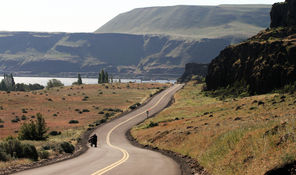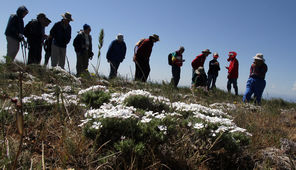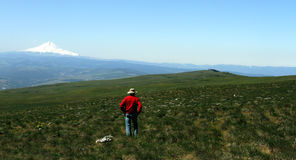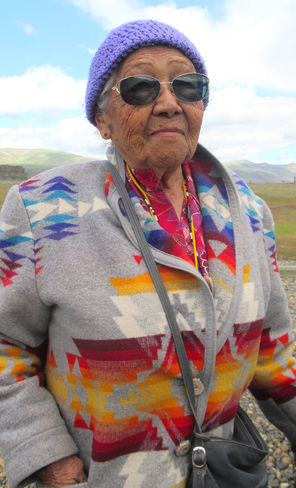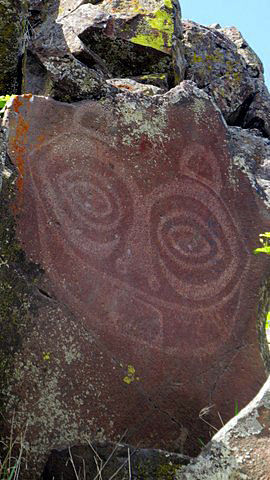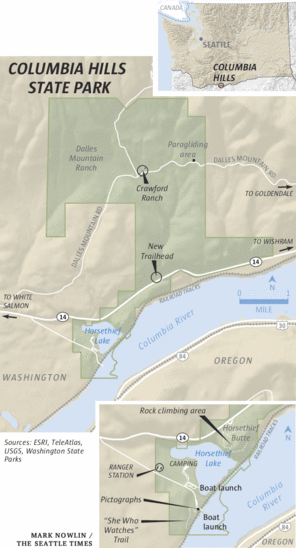Originally published May 16, 2013 at 12:31 PM | Page modified June 21, 2013 at 1:07 PM
This is the third park profile in a five-part series on Washington state parks, in observance of the park system’s centennial. Find more at seattletimes.com/travel. This is the third park profile in a five-part series on Washington state parks, in observance of the park system’s centennial. Find more at seattletimes.com/travel.
Columbia Hills State Park is a Gorge wonder
‘Gems of Our Washington State Parks’ series profiles a park with history, artifacts and eye-popping scenery in the Columbia River Gorge.
Seattle Times Outdoors editor
Alan Berner / The Seattle Times
Upon entering Columbia Hills State Park there’s a sweeping view down to the Columbia River. The park offers scenic grandeur and a treasure of cultural artifacts.
Alan Berner / The Seattle Times
A group enjoys the wildflowers atop Stacker Butte. Volunteer Barbara Robinson, right, points out what's what.
Alan Berner / The Seattle Times
It’s a 360-degree view from the top of 3,200-foot Stacker Butte. Snow-covered Mount Hood rises in the background. Mount Adams and Mount Rainier also can be seen from the butte.
Brian J. Cantwell / The Seattle Times
90-year-old Viola Kalama, a tribal member from Warm Springs, Ore., grew up in what’s now the park.
If you go
A gem of a park in the Columbia Gorge
The park’s uplands were formerly the 3,200-acre Dalles Mountain Ranch, purchased by the state in the early 1990s and later combined with existing Horsethief Lake State Park, at the river’s edge, to form the renamed Columbia Hills State Park.
Getting there
From Seattle, it’s about four hours by car. Take Interstate 90 over Snoqualmie Pass to Ellensburg, then follow Interstate 82 and U.S. Highway 97 south through the Yakima Valley and over Satus Pass to the Columbia River. Discover Pass required in the park.
Traveler’s tip
The park is within the Columbia River Gorge National Scenic Area: fs.usda.gov/crgnsa
More information
509-767-1159 or parks.wa.gov/parks/?selectedpark=Columbia Hills
![]()
Gems of our Washington State Parks
DALLESPORT, Klickitat County — It’s hard to overstate the grandeur of the Columbia River Gorge, and Columbia Hills State Park takes in a sweeping mountainside of that grandeur, plus a riverside trove of cultural artifacts that may be unmatched in the Northwest.
For an experience nothing like what you might find at crowded parks such as Deception Pass, drive up winding, graveled Dalles Mountain Road here and search out the one-room pioneer hut — “cabin” is too grand a term — built by Henry Brune, a German war hero from the Franco-Prussian War of 1870.
Stand alone at his doorway — you might be the only person for miles around — and look down on countless graduated slopes and plateaus of windblown grassland and high desert. Built by lava flows and scoured by ancient floods, the land is crinkled from time and erosion, probably much like the lined face of Brune himself were he still around to take it in.
In April and May, cheerful yellow flowers of arrowleaf balsamroot waggle in the breezes next to purple lupine among the grasses. Pockets of gnarled oaks and Osage orange, planted by early settlers, line gulches.
On a clear day, Mount Hood rises like a shark fin to the southwest, across the Columbia River. If you hike from the park’s upper boundary two miles up a gated road to the top of 3,200-foot Stacker Butte, you get an eyeful of Hood, Mount Adams, Mount Rainier, Mount Jefferson and more in “a 360-degree view that will just knock your socks off,” says Ranger Andy Kallinen, who runs this 3,338-acre park in south-central Washington.
What makes it a gem
Upland grandeur aside, the cultural artifacts documenting Native American life on the river’s shore, along with history related to the Lewis and Clark Expedition, put this park on our Seattle Times “state park gems” list.
For hundreds of years the riverbank here was the site of the native Wishram people’s main village, called Nix lui dix, or “The Trading Place.” Situated between famed Celilo Falls and narrow river channels just downstream, it was an ideal place to catch salmon, attracting tribes from throughout the Pacific Northwest to fish and trade.
Explorers Lewis and Clark stayed at the village on both legs of their journey, westward in 1805 and returning east the following spring. They wrote of it as the first place in the Northwest they found “large and comodious (sic)” native homes built of wood — Chinookan-style lodges.
The lower park and campground around Horsethief Lake is “intimate and comfortable, and a beautiful spot with a lot of history,” campground host Andy Forrest, from Kirkland, said as he and his wife, Julie, warmed themselves by a campfire on a cool spring morning. “We like American history, and we’ve been interested in Lewis and Clark for a number of years.”
“And you can see a part of the Oregon Trail from here,” added Julie, pointing across the Columbia to a diagonal line in the canyon wall, where remnants of a wagon path still lead down to the water — a detour route used when a creek was too high on the main trail.
What you won’t find everywhere
Nix lui dix, along with Celilo Falls, was buried under water from The Dalles Dam in 1957, but many artifacts remain, including ancient rock paintings (pictographs) and carvings (petroglyphs), some rescued from the flooding and brought to the park for outside display and others in their original rock cliffs overlooking the village site.
On my visit, a group of Oregon State Parks staff toured the park and was lucky to meet near the river’s edge with Viola Kalama, 90, a Warm Springs tribal member who grew up in Nix lui dix. She told stories of the Gorge’s most famous petroglyph, Tsagaglalal, or “She Who Watches,” a large, wide-eyed face with a knowing grin that can still be clearly seen in a basalt wall overlooking the Columbia.
“We’d play and run all along those cliffs and there were petroglyphs all along. We’d try to hide but that face would keep watching us! The face lady was the ruler of the land,” Kalama said. “This was a beautiful place and a wonderful country. I cried the year the water started going up.”
Today, to protect “She Who Watches” from vandalism, the park trail accessing the area is open only during free guided tours, conducted at 10 a.m. every Friday and Saturday, April to October, by reservation only (509-767-1159; call well in advance of a planned visit, as tours are limited to 25 people and usually fill).
Other rescued rock paintings and carvings are open to viewing daily. They include remarkable representations of big-eared owls, sharp-fanged coyotes, deer, sun and other natural wonders of importance to people who first lived here hundreds and thousands of years ago.
Not to be missed
Stories vary as to how Horsethief Lake and neighboring Horsethief Butte got their names. Some say robbers swooped down from the butte to stop westbound trains carrying horses bound for the Klondike in the 1890s. Others suggest that dam builders in the 1950s thought the area looked like a setting for a Hollywood western and bequeathed the name.
In any case, they are two of the park’s primary recreational features.
The 90-acre Horsethief Lake is an impoundment of the dam-raised river, cut off by a railroad causeway, though small culverts provide an outlet. Fishing and boating are attractions, with pedal boats and other rentals in summer months.
On weekends, Portland-area rock climbers flock to the 500-foot walls of Horsethief Butte. A recently built parking area off Highway 14 serves as trailhead for an easy walk that skirts dramatic basalt spires and offers on-high views of the broad river and passing barges. Some trails enable a scramble/boulder hop to the top. Beware of rattlesnakes, poison oak, ticks and occasional high winds.
Where to lay your head
Some day, Henry Brune’s hut may be offered as an off-the-grid vacation rental, along with a nearby ranch house. For now, the park’s small campground — 12 RV sites and six primitive tent sites — is the only place to stay in the park (reservations advised in summer: 888-226-7688 or https://secure.camis.com/WA ). The Dalles, Ore., a 10-minute drive away across the Columbia, offers multiple lodging options. The Dalles Inn, in the historic downtown, offers good rates on renovated rooms, with restaurants and brew pubs within walking distance (www.thedallesinn.com).
Just for fun
• For birdwatchers, Columbia Hills State Park is raptor country. “There are a ton of different raptors, a lot of different owls, harriers, redtails, kestrels, golden and bald eagles,” Kallinen, the park ranger, said. “You’ll see them out here riding thermals in a clear, blue sky — they can stay up for hours.”
• For a taste of the Old West, drive up Dalles Mountain Road to the ghost-town-like Crawford Ranch homesite, including intact, rustic barns and outbuildings representative of early 20th-century ranch life. Historical farm equipment is displayed, encircling a tiny family gravesite with stones dating to the 1880s.
• Come July or so, be among the first to try out a new trail system soon to be completed on The Dalles Mountain uplands, incorporating an old military road that once connected the Yakima Valley’s 1850s-era Fort Simcoe to Fort Dalles.
“We’ll have over six miles of beautiful single-track trails for equestrians, mountain bikers and hikers through some of the greatest wildflower and view areas in the Gorge,” Kallinen said.
A new trailhead-parking area will open on the north side of Highway 14. Call the park to check on opening dates.
Next month: Moran State Park on Orcas Island.
Brian J. Cantwell: 206-748-5724 or bcantwell@seattletimes.com





